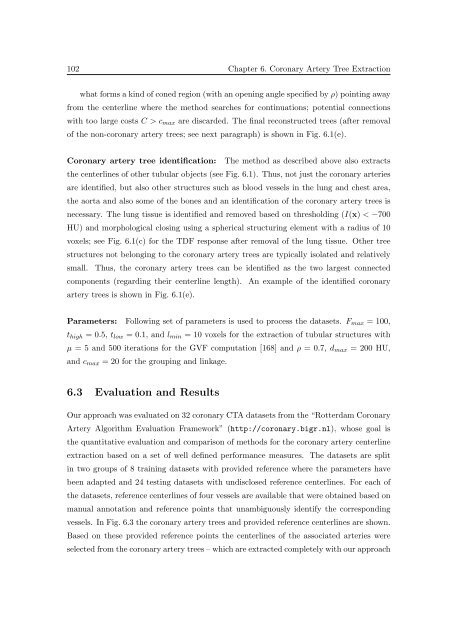Segmentation of 3D Tubular Tree Structures in Medical Images ...
Segmentation of 3D Tubular Tree Structures in Medical Images ...
Segmentation of 3D Tubular Tree Structures in Medical Images ...
You also want an ePaper? Increase the reach of your titles
YUMPU automatically turns print PDFs into web optimized ePapers that Google loves.
102 Chapter 6. Coronary Artery <strong>Tree</strong> Extraction<br />
what forms a k<strong>in</strong>d <strong>of</strong> coned region (with an open<strong>in</strong>g angle specified by ρ) po<strong>in</strong>t<strong>in</strong>g away<br />
from the centerl<strong>in</strong>e where the method searches for cont<strong>in</strong>uations; potential connections<br />
with too large costs C > c max are discarded. The f<strong>in</strong>al reconstructed trees (after removal<br />
<strong>of</strong> the non-coronary artery trees; see next paragraph) is shown <strong>in</strong> Fig. 6.1(e).<br />
Coronary artery tree identification: The method as described above also extracts<br />
the centerl<strong>in</strong>es <strong>of</strong> other tubular objects (see Fig. 6.1). Thus, not just the coronary arteries<br />
are identified, but also other structures such as blood vessels <strong>in</strong> the lung and chest area,<br />
the aorta and also some <strong>of</strong> the bones and an identification <strong>of</strong> the coronary artery trees is<br />
necessary. The lung tissue is identified and removed based on threshold<strong>in</strong>g (I(x) < −700<br />
HU) and morphological clos<strong>in</strong>g us<strong>in</strong>g a spherical structur<strong>in</strong>g element with a radius <strong>of</strong> 10<br />
voxels; see Fig. 6.1(c) for the TDF response after removal <strong>of</strong> the lung tissue. Other tree<br />
structures not belong<strong>in</strong>g to the coronary artery trees are typically isolated and relatively<br />
small. Thus, the coronary artery trees can be identified as the two largest connected<br />
components (regard<strong>in</strong>g their centerl<strong>in</strong>e length). An example <strong>of</strong> the identified coronary<br />
artery trees is shown <strong>in</strong> Fig. 6.1(e).<br />
Parameters: Follow<strong>in</strong>g set <strong>of</strong> parameters is used to process the datasets. F max = 100,<br />
t high = 0.5, t low = 0.1, and l m<strong>in</strong> = 10 voxels for the extraction <strong>of</strong> tubular structures with<br />
µ = 5 and 500 iterations for the GVF computation [168] and ρ = 0.7, d max = 200 HU,<br />
and c max = 20 for the group<strong>in</strong>g and l<strong>in</strong>kage.<br />
6.3 Evaluation and Results<br />
Our approach was evaluated on 32 coronary CTA datasets from the “Rotterdam Coronary<br />
Artery Algorithm Evaluation Framework” (http://coronary.bigr.nl), whose goal is<br />
the quantitative evaluation and comparison <strong>of</strong> methods for the coronary artery centerl<strong>in</strong>e<br />
extraction based on a set <strong>of</strong> well def<strong>in</strong>ed performance measures. The datasets are split<br />
<strong>in</strong> two groups <strong>of</strong> 8 tra<strong>in</strong><strong>in</strong>g datasets with provided reference where the parameters have<br />
been adapted and 24 test<strong>in</strong>g datasets with undisclosed reference centerl<strong>in</strong>es. For each <strong>of</strong><br />
the datasets, reference centerl<strong>in</strong>es <strong>of</strong> four vessels are available that were obta<strong>in</strong>ed based on<br />
manual annotation and reference po<strong>in</strong>ts that unambiguously identify the correspond<strong>in</strong>g<br />
vessels. In Fig. 6.3 the coronary artery trees and provided reference centerl<strong>in</strong>es are shown.<br />
Based on these provided reference po<strong>in</strong>ts the centerl<strong>in</strong>es <strong>of</strong> the associated arteries were<br />
selected from the coronary artery trees – which are extracted completely with our approach















